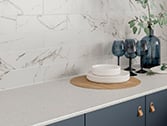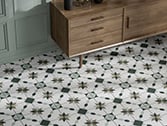How To Clean Mould From Your Grout


Despite cleaning and maintaining your tiles correctly, unfortunately the porous nature of grout makes it the perfect area for mould to appear.
Mould is caused by excess moisture and thrives in warm damp conditions with poor ventilation; making bathrooms, utilities and bathrooms the perfect areas for mould to grow.
It is really important to keep mould at bay. Not only does it impact the aesthetic of the room, it can also pose health risks to you and your family due to toxins it can release into the air. Luckily, there are some simple yet effective ways to remove mould.
What is mould?
Mould is a species of fungi that thrives in damp environments. If left to grow, mould can spread very quickly, at around a rate of one square inch per day.
Dark green or black in colour, mould can also be identified by it’s musky smell. The mould itself is not harmful, however the toxins it produces in the air can be if left to fester.
What are the health risks?
Breathing in these toxins can cause respiratory problems and may cause symptoms similar to a common cold; coughing, runny nose, sore throat, breathlessness and sometimes even nosebleeds.
Mould can also aggravate existing health problems like asthma, and can be a higher risk to those with lung disease or a weak immune system.
Therefore, it’s really important to remove mould if you notice any appearing in typically damp areas and prevent it coming back in the future.
How To Remove Mould From Grout
Fortunately, there are a variety of chemical cleaning agents available to remove mould. Mould tends to be quite stubborn, so most remedies do require a good amount of elbow grease, patience and consistent cleaning.
It’s important to consider your safety before attempting to tackle mould. Wear non-porous gloves to protect your skin and goggles or safety glasses to prevent any splashback getting into your eyes.
The area should also be as ventilated as possible to prevent the inhalation of fumes from either the mould itself or the solutions.
Professional Cleaning Solutions
There are many pre-made chemical cleaning solutions, specifically designed to remove mould.
These chemical options are a good solution for extensive mould, as sometimes natural remedies won’t be sufficient enough at restoring the grout. They are also specifically designed for use on tiles, whereas home remedies run the risk of causing damage to your tiles.
Vitrex Mould Remover
The Vitrex Mould Remover can be used frequently enough to maintain the natural beauty of your tiles and grout, straight from the bottle. With a handy spray bottle top, apply directly to grout joints and remove the dissolved grout with a wet sponge.
Affordable and easy to use, this mould remover is effective in restoring your grout to new.
LTP Grimex Tile & Grout Cleaner
Some mould stains are more stubborn, due to longer time periods that it has settled on the porous grout. In these instances, you may require a stronger solution for a bigger impact on cleaning away the mould.
We recommend the LTP Grimex Tile & Grout Cleaner, and so do our customers, who agreed with effectiveness of the solution with 5* reviews.
Solutions should always be patch tested in an inconspicuous area before applying to the whole surface area. However, this solution is suitable for use on both artificial and natural tiles, including natural stones and porcelain.
A stronger cleaning solution reduces the amount of hours and effort it would take to remove stubborn mould with natural alternatives.
Tips To Prevent Grout In Future
After all the hard work of cleaning your grout from mould, prevention is the best cure.
To keep mould under control, there are a number of things you can do to prevent it and deprive it of what it thrives on - moisture. We’ve put some tips below to reduce moisture and keep mould at bay once your tiles have been restored:
- Open windows for around 15 minutes after showering or going in the bath. Also wipe down tiles with a towel, cloth or squeegee and shake shower curtain. This will remove excess water and help with the drying process.
- Hand damp towels up after use. Wet towels will contribute to moisture in the room, so hanging them up will help them dry quicker.
- Spray tiles with a mould-prevention solution after they have been wet. Either a pre-made solution, or a 50/50 mix of water and white vinegar would be effective.
- Keep shower doors/curtains open when not in use.
- When cooking, keep kitchen windows open to allow steam to escape from the room.
- Keep laundry and utility rooms as ventilated as possible, especially whilst washing or if appliances are on.
- Keep tiles as clean as possible to prevent soap build up. This will add porous deposit to your tiles which is a perfect place for mould to appear.
- Fix any leaks that you are aware of. Leaks will provide a constant source of moisture in a room.
- Seal grout with silicone, or use a grout paint or pen. Sealants will reduce the speed at which moisture can penetrate the porous grout, so it wouldn’t get as wet and would also dry quicker. They also look great and keep grout looking fresh whilst preventing future grout.
Need further help? Contact our customer service team on 0330 053 3362 or [email protected]

















